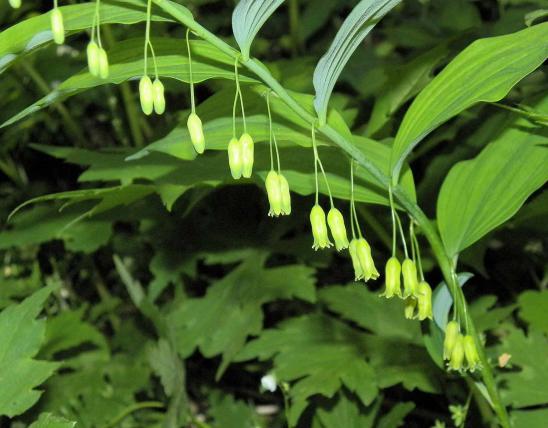
False Solomon's seal is an herbaceous perennial growing from a long, creeping rhizome. The stalk is arching, usually unbranched, and slightly zigzags between the leaf nodes. The flowers are in a plumelike cluster of minute florets arising from the tips of the plant stalks, fragrant, creamy white. Blooms May–June. The leaves are alternate, spreading horizontally in 2 ranks, broadly elliptical, similar to those of true Solomon's seal (Polygonatum biflorum) but with fewer veins. The fruits are red berries, often with purple dots.
Similar species: Although the foliage is quite similar, the flower arrangement of the true and the false Solomon’s seals is so different that identification presents no problem. Also, the fruits of true Solomon's seal are dark blue at maturity, not red.
Stem length: 2–3 feet.

Statewide.
Habitat and Conservation
Common statewide in rich soils of bottomland and upland forests.
Status
Using new technology, botanists are using molecular (DNA) characteristics to provide new insights into the relationships among plant groups, and recently they've been dividing several large plant families into new, smaller, separate families. False Solomon's seal, in the newer classification system, is now placed in the Asparagaceae, the asparagus family. The the asparagus family represents a division of plants that are all former members of the Liliaceae (lily family).
Human Connections
False Solomon's seal is a popular native plant for landscaping in partially shady locations, as it offers pretty sprays of flowers, bright berries, and interesting foliage, which turns yellow in fall.
The young shoots can be cooked and eaten like asparagus, in all the ways asparagus might be served: as a side dish, in stir-fries, omelets, casseroles, soups, and so on. Since collecting this way may kill the plant, only harvest this native wildflower where it very abundant, and do not overcollect in any given area.
The ripe berries may also be eaten raw or cooked. Note that they are said to have laxative properties, especially if you eat a lot of them
The roots of this species have been used medicinally.
This plant was named "false Solomon's seal" because of its resemblance to a plant called Solomon's seal.
Ecosystem Connections
Various bees, flies, and beetles are attracted to the flowers.
Fruit-eating birds, as well as rodents, eat the berries and thereby spread the seed to new areas.
Deer and other herbivores browse the foliage.
























